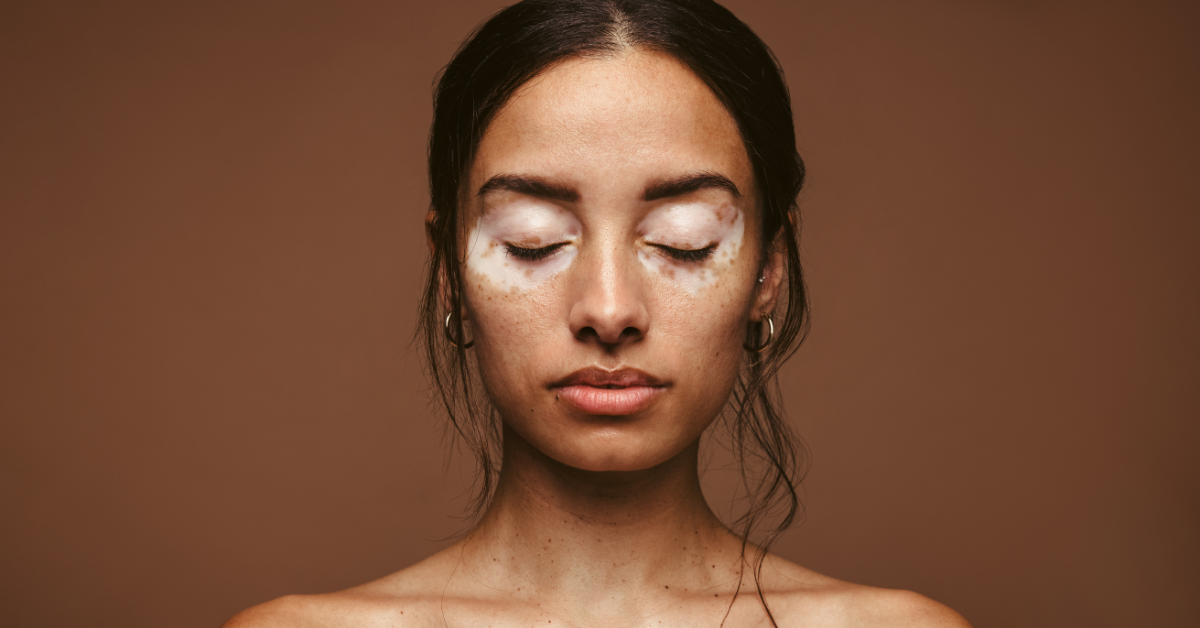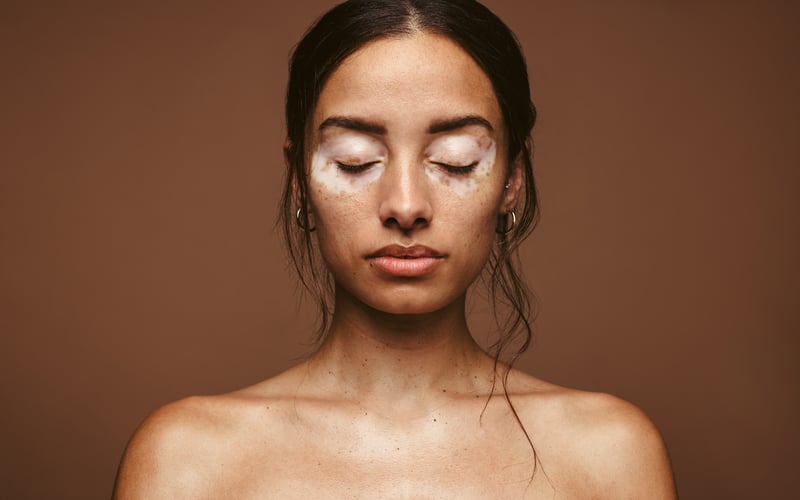
25 Jun, 2024
Every 25 June, since 2011, World Vitiligo Day has been celebrated in Italy and around the world. It is an important opportunity to raise awareness about an autoimmune disease that affects millions of people and can have profound physical and emotional implications.
In this article we explore causes, symptoms, therapeutic options and the importance of psychological support for patients suffering from vitiligo, to deal with this pathology with greater knowledge and empathy, with the help of Prof. Franco Rongioletti, Professor of Dermatology UniSR, founder and director of the Postgraduate School of Dermatology and Venereology UniSR and Director of the Clinical Dermatology Operating Unit of the IRCCS San Raffaele Hospital, and of Prof. Anna Ogliari, Associate Professor of Clinical Psychology and Director of the Postgraduate School in Clinical Psychology UniSR.
.jpg?width=800&height=480&name=Vitiligine_pelle_UniSR%20(1).jpg)
Vitiligo: symptoms
Vitiligo is an autoimmune disease characterized by the loss of melanocytes, the cells responsible for the production of melanin, the pigment that gives color to the skin. The lack of melanocytes causes milk-white patches of skin, often symmetrical, to appear on any part of the body, particularly on the face, hands, and genitals. It may also occur with premature discoloration of hair and beard, but also of eyelashes or eyebrows, making them white or, again, with discoloration of the mucous membranes of the mouth and nose or with changes in the color of the retina.

Causes and incidence of vitiligo
The exact cause of vitiligo is not completely known; it may be associated with other autoimmune diseases, such as thyroiditis and alopecia areata, and is believed to result from a combination of genetic, environmental, and immune system factors. Stress, skin trauma, chemical exposure and infection can trigger or exacerbate the condition in genetically predisposed individuals.
An estimated 0.5-2% of the world's population is affected, without significant distinction by gender, ethnicity or geographic region. In dark-skinned people, however, the contrast between depigmented and healthy skin can accentuate the perception of diversity and lead to increased social stigma.

Available treatments
While there is no definitive cure, there are several treatment options that help manage the disease by alleviating its symptoms. Topical treatments include corticosteroid ointments and calcineurin inhibitors (a protein involved in a wide variety of biological responses) useful for treating sensitive areas such as the face and neck. Recently, ruxolitinib cream, an inhibitor of the Janus kinase (JAK) family of enzymes, has been approved for the treatment of nonsegmental vitiligo (characterized by symmetrical patches on both sides of the body) with facial involvement, in patients 12 years of age and older, demonstrating efficacy in pigmentation of affected areas.

For extensive lesions, however, narrow-band UVB phototherapy is considered, administered in clinics or at home with special devices. Systemic treatments with oral corticosteroids are used to control rapidly progressive forms, but are not ideal for long-term use because of side effects. Oral JAK inhibitors also show promising results in clinical trials and represent a new frontier in the treatment of vitiligo. Several other treatments, including phosphodiesterase 4 inhibitors, growth factors, and genetic therapies, are being tested and may offer new hope for the future.

Psychological impact of vitiligo
Vitiligo is not only a cosmetological problem: depigmented spots can lead to feelings of embarrassment, anxiety, and depression, negatively affecting quality of life and self-esteem. Body perception and social interaction can be severely impaired, leading to social isolation. It is therefore crucial to address vitiligo with a personalized approach that considers both the physical and emotional aspects of the disease.

The importance of psychological support
Like all chronic illnesses, vitiligo can have a great impact on overall psychological well-being and be a hindrance, especially in childhood and adolescence, a phase of transformation and transition in many ways: the body changes, emotional, cognitive, relational, and identity skills mature. Aesthetic impairment can affect the construction of one's body image and sense of identity and result in social anxiety in sufferers. A complex condition, particularly common during adolescence, involving fear and concern about the gaze and judgment of others.
Numerous studies have shown an increased likelihood of developing anxiety or depressive symptoms, both following diagnosis and as the disease itself develops. Patients' quality of life, however, appears to be related not only to the course of vitiligo, but also to the degree of acceptance of the disease.
.jpg?width=800&height=534&name=Vitiligine_pelle_UniSR%20(2).jpg)
A non-judgmental social network
Support from friends and family can be of great help in the difficult journey of accepting and living with vitiligo. In fact, a good supportive and non-judgmental social network can significantly improve the quality of life by fostering the possibility of feeling welcomed, validated, and "looked at" not through the lens of pathology but through the enhancement of the individual's strengths.
Friends and family can play an important role in improving quality of life by suggesting the possibility of psychological support where anxiety and depression become disabling to the subject's own life.

The positive impact of a psychological journey
The psychological strategies that can be implemented by a professional are mainly aimed at modifying possible dysfunctional strategies (such as avoidance, or low self-esteem, but also a state of constant alertness) that the person with vitiligo may put in place to escape the uncomfortable situations that the disease causes. Psychological support or psychotherapy can also help build more functional and adaptive thoughts, going to replace the dysfunctional thoughts that usually worsen the sufferer's quality of life.

World Vitiligo Day reminds us of the importance of recognizing and understanding the challenges faced by those living with this condition. Although there is no definitive cure, advances in research and treatment options offer hope and improvements in the management of the disease. Early intervention, however, is essential, not only medically but also psychologically, to help patients build greater self-acceptance and help improve their quality of life.
La Giornata Mondiale della Vitiligine ci ricorda l'importanza di riconoscere e comprendere le sfide affrontate da chi vive con questa condizione. Sebbene non esista una cura definitiva, i progressi nella ricerca e nelle opzioni terapeutiche offrono speranza e miglioramenti nella gestione della malattia. È essenziale, però, un intervento tempestivo non solo medico, ma anche psicologico, per aiutare i pazienti a costruire una maggiore accettazione di sé e contribuire a migliore la loro qualità della vita.
Are you passionate about Psychology and also want to make a difference and contribute to improving people's well-being? Discover the Educational Offerings of the UniSR Faculty of Psychology.
References
-
J Prev (2022) 2024 Jun 1 doi: 10.1007/s10935-024-00784-0. Global Prevalence of Anxiety, Depression, and Stress Among Patients with Skin Diseases: A Systematic Review and Meta-analysis. Nader Salari 1 2, Pegah Heidarian 3, Amin Hosseinian-Far 4, Fateme Babajani 5, Masoud Mohammadi 6
-
Clinical Features of Vitiligo and Social Impact on Quality of Life.
-
Seneschal J.Dermatol Pract Concept. 2023 Dec 1;13(4S2):e2023312S. doi: 10.5826/dpc.1304S2a312S.
-
The psychosocial impacts of vitiligo, psoriasis, and alopecia areata on pediatric patients.
-
Cruz S, Lei DK, Carr H, Rosenblatt A.Dermatol Online J. 2023 Apr 15;29(2). doi: 10.5070/D329260765
